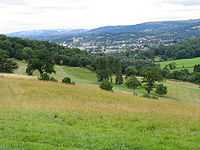Leckhampton Hill and Charlton Kings Common
| Site of Special Scientific Interest | |
|
Cliff face on Leckhampton Hill | |
 Shown within Gloucestershire | |
| Area of Search | Gloucestershire |
|---|---|
| Grid reference | SO952187 |
| Coordinates | 51°52′02″N 2°04′13″W / 51.867306°N 2.070391°WCoordinates: 51°52′02″N 2°04′13″W / 51.867306°N 2.070391°W |
| Interest | Biological/Geological |
| Area | 63.8hectare |
| Notification | 1954 |
| Natural England website | |
Leckhampton Hill and Charlton Kings Common (grid reference SO952187) is a 63.8-hectare (158-acre) biological and geological Site of Special Scientific Interest in Gloucestershire, notified in 1954.[1][2] There are five units of assessment.[3]
The site is listed in the 'Cotswold District' Local Plan 2001-2011 (on line) as a Key Wildlife Site (KWS).[4]
Location
The site is in the Cotswold Area of Outstanding Natural Beauty and is one of a series of unimproved Jurassic limestone grassland area which are located along the Cotswold scarp. It is south of Cheltenham and near the communities of Leckhampton and Charlton Kings, and has a north-facing aspect. The site also includes disused quarry faces, and quarry spoil which has been vegetated.[1]
Geology
The Leckhampton quarries expose the thickest single cross-section through the Middle Jurassic, Inferior Oolite strata of the area. They are a major research interest, and there are many published accounts of the last 150 years. Strata of some 60 m are exposed, and the large outcrops are of significant importance to those studying palaeontology or sedimentology, and for studying ancient environments generally.[1]
Biology
The site supports a range of habitats which include unimproved calcareous grassland, woodland and scrub, cliff faces and scree slopes. The grassland is of major importance and it comprises a tall ungrazed sward. This is dominated by Tor-grass, Upright Brome, Meadow Oat-grass, Sweet Vernal-grass and Quaking Grass. It is noted for its range of herbs which include Salad Burnet, Common Rock-rose, Common Bird's-foot-trefoil. The quarry floors support Wild Thyme, Dwarf Thistle, Yellow-wort and Autumn Gentian. The site supports many plants which are scarce at a national or county level. These include Fly Orchid, Musk Orchid and Purple Milk-vetch. It is one of a small number of sites which support Meadow Clary in the county.[1]
Shrub areas support nesting birds such as Meadow Pipit and Grasshopper Warbler. It is a shelter area for invertebrates and small mammals.[1]
There are wooded areas of broad-leaved and coniferous trees including mature Beech. These areas support a woodland flora such as Ivy Broomrape, White Helleborine and Greater Butterfly-orchid.[1]
There is a reported population of the Adder.[1]
References
- ↑ 1.0 1.1 1.2 1.3 1.4 1.5 1.6 Natural England SSSI information on the citation
- ↑ Tewkesbury Borough Local Plan to 2011, adopted March 2006, Appendix 3 'Nature Conservation', Sites of Special Scientific Interest
- ↑ Natural England SSSI information on the Leckhampton Hill And Charlton Kings Common units
- ↑ Cotswold District Local Plan, Appendix 2, Key Wildlife Sites
SSSI Source
- Natural England SSSI information on the citation
- Natural England SSSI information on the Leckhampton Hill and Charlton Kings Common units
External links
- Natural England (SSSI information)
-

View from Leckhampton Hill
-

Paths on Leckhampton Hill
-

Toposcope on Leckhampton Hill
-

Cotswold Way on Leckhampton Hill
-

Cliff faces on Leckhampton Hill
-

Devil's Chimney, Leckhampton Hill
-

Lower slopes of Charlton Kings Common
-

Footpath on Charlton Kings Common
| ||||||||||||||
